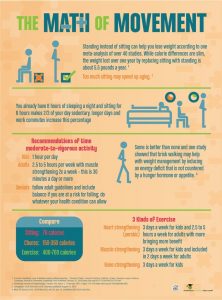Physical activity is one of the keys to fighting prediabetes. Our Prediabetes Exercise poster outlines a three-prong approach based on recommendations from the American Diabetes Association.
It seems simple enough: exercise for 150 minutes per week, throw in some strength training, and don’t sit too much. But for many folks, just the thought of working out can be overwhelming. One solution is to do exercise videos at home.
There are plenty of free exercise videos on YouTube, but your clients need direction to find the right ones. Here are some good choices to go along with the three prongs on our Prediabetes Exercise poster:
150 minutes of moderate to vigorous exercise per week:
- You can’t go wrong with any walking video by Leslie Sansone. There are so many to choose from, all free on YouTube. Here are a few basics:
- The National Institute on Aging’s Go4Life exercise videos are geared to seniors, but they’re also perfect for beginners and people with foot, ankle, knee, or hip issues:
- This 30-minute Low Impact YMCA workout sticks to the basics but is challenging enough for beginners of all ages.
- SparkPeople’s Seated Cardio Workout is not your grandmother’s chair exercise!
Resistance/strength training 2-3 times per week:
- Strength Training 101 from the MD Anderson Cancer Center shows how to do six exercises with modifications for beginners.
- The National Institute on Aging’s 15-Minute Beginner Strength Training is good for any age.
- Mayo Clinic has a “Deskercise” Series of short strength videos you can do at your desk.
Three minutes of light activity every half hour while sitting:
- American Institute for Cancer Research’s perfectly-timed 3-Minute Office Workout.
- MD Cancer Center’s Flex at Your Desk.
- Exercise at Your Desk from Nebraska Medicine.
And here are two bonus recommendations:
- Instant Recess: 5-Minute Physical Activity Break from UC Berkley: GREAT for your classes, individual counseling sessions, and work meetings!
- Move Your Way is the promotional campaign for the second edition of the Physical Activity Guidelines for Americans. The campaign has four videos on YouTube. These are not exercise videos, but they provide simple and do-able tips to help everyone find ways to get moving.




